Broad Luminescence Generated by IR Laser Excitation from CsPbBr3:Yb3+ Perovskite Ceramics
Abstract
:1. Introduction
2. Results and Discussion
2.1. Structural and Optical Properties
2.2. Photoconductivity
2.3. Energy Transfer Mechanism
3. Materials and Methods
4. Conclusions
Author Contributions
Funding
Institutional Review Board Statement
Informed Consent Statement
Data Availability Statement
Conflicts of Interest
Sample Availability
References
- Akkerman, Q.A.; Manna, L. What Defines a Halide Perovskite? ACS Energy Lett. 2020, 5, 604–610. [Google Scholar] [CrossRef] [Green Version]
- Manser, J.S.; Saidaminov, M.I.; Christians, J.A.; Bakr, O.M.; Kamat, P.V. Making and Breaking of Lead Halide Perovskites. Acc. Chem. Res. 2016, 49, 330–338. [Google Scholar] [CrossRef] [PubMed] [Green Version]
- Zhao, Y.; Zhu, K. Organic-Inorganic Hybrid Lead Halide Perovskites for Optoelectronic and Electronic Applications. Chem. Soc. Rev. 2016, 45, 655–689. [Google Scholar] [CrossRef]
- Akkerman, Q.A.; Rainò, G.; Kovalenko, M.V.; Manna, L. Genesis, Challenges and Opportunities for Colloidal Lead Halide Perovskite Nanocrystals. Nat. Mater. 2018, 17, 394–405. [Google Scholar] [CrossRef]
- Rosales, B.A.; Hanrahan, M.P.; Boote, B.W.; Rossini, A.J.; Smith, E.A.; Vela, J. Lead Halide Perovskites: Challenges and Opportunities in Advanced Synthesis and Spectroscopy. ACS Energy Lett. 2017, 2, 906–914. [Google Scholar] [CrossRef]
- Shen, W.; Chen, J.; Wu, J.; Li, X.; Zeng, H. Nonlinear Optics in Lead Halide Perovskites: Mechanisms and Applications. ACS Photonics 2021, 8, 113–124. [Google Scholar] [CrossRef]
- Zhou, D.; Liu, D.; Pan, G.; Chen, X.; Li, D.; Xu, W.; Bai, X.; Song, H. Cerium and Ytterbium Codoped Halide Perovskite Quantum Dots: A Novel and Efficient Downconverter for Improving the Performance of Silicon Solar Cells. Adv. Mater. 2017, 29, 1704149. [Google Scholar] [CrossRef] [PubMed]
- Luo, X.; Ding, T.; Liu, X.; Liu, Y.; Wu, K. Quantum-Cutting Luminescent Solar Concentrators Using Ytterbium-Doped Perovskite Nanocrystals. Nano Lett. 2019, 19, 338–341. [Google Scholar] [CrossRef]
- Groenewegen, H. Energy Transfer Processes in Ytterbium Doped Metal Halide Perovskites Probed with Cathodoluminescence. Master Thesis, Universiteit van Amsterdam, Amsterdam, The Netherlands, 2021. Available online: https://www.lmpv.nl/wp-content/uploads/2022/01/Heleen-Groenewegen-Master-Thesis-UvA-2021.pdf (accessed on 5 June 2023).
- Wang, J.; Tanner, P.A. Upconversion for White Light Generation by a Single Compound. J. Am. Chem. Soc. 2010, 132, 947–949. [Google Scholar] [CrossRef]
- Gonçalves, J.M.; Stefanski, M.; Tomala, R.; Musialek, A.; Strek, W. Laser Induced White Emission Generation from La1−xNdxAlO3 Nanocrystals. Dalt. Trans. 2023, 52, 2073–2079. [Google Scholar] [CrossRef]
- Stefanski, M.; Głuchowski, P.; Strek, W. Laser Induced Emission Spectra of Gallium Nitride Nanoceramics. Ceram. Int. 2020, 46, 29060–29066. [Google Scholar] [CrossRef]
- Strek, W.; Marciniak, L.; Bednarkiewicz, A.; Lukowiak, A.; Wiglusz, R.; Hreniak, D. White Emission of Lithium Ytterbium Tetraphosphate Nanocrystals. Opt. Express 2011, 19, 14083–14092. [Google Scholar] [CrossRef] [PubMed]
- Strek, W.; Tomala, R.; Marciniak, L.; Lukaszewicz, M.; Cichy, B.; Stefanski, M.; Hreniak, D.; Kedziorski, A.; Krosnicki, M.; Seijo, L. Broadband Anti-Stokes White Emission of Sr2CeO4 Nanocrystals Induced by Laser Irradiation. Phys. Chem. Chem. Phys. 2016, 18, 27921–27927. [Google Scholar] [CrossRef] [PubMed]
- Strek, W.; Tomala, R.; Lukaszewicz, M.; Cichy, B.; Gerasymchuk, Y.; Gluchowski, P.; Marciniak, L.; Bednarkiewicz, A.; Hreniak, D. Laser Induced White Lighting of Graphene Foam. Sci. Rep. 2017, 7, 41281. [Google Scholar] [CrossRef] [PubMed] [Green Version]
- Chaika, M.A.; Tomala, R.; Strek, W. Infrared Laser Stimulated Broadband White Emission of Transparent Cr:YAG Ceramics Obtained by Solid State Reaction Sintering. Opt. Mater. 2021, 111, 110673. [Google Scholar] [CrossRef]
- Chaika, M.; Tomala, R.; Strek, W. Surface Related Laser Induced White Emission of Cr:YAG Ceramic. Sci. Rep. 2021, 11, 14063. [Google Scholar] [CrossRef]
- Chaika, M.; Balabanov, S.; Strek, W. Surface Related White Light Emission in Yb2O3 Transparent Nanoceramics. Mater. Res. Bull. 2023, 157, 112011. [Google Scholar] [CrossRef]
- Chaika, M.; Tomala, R.; Oleszko, M.; Strek, W. Surface-Related White Light Emission Phenomenon in Transparent Solids. MRS Adv. 2022, 7, 1095–1098. [Google Scholar] [CrossRef]
- Stefanski, M.; Lukaszewicz, M.; Hreniak, D.; Strek, W. Laser Induced White Emission Generated by Infrared Excitation from Eu3+:Sr2CeO4 Nanocrystals. J. Chem. Phys. 2017, 146, 104705. [Google Scholar] [CrossRef]
- Stefanski, M.; Hreniak, D.; Strek, W. Broadband White Emission from Yb3+ Doped Sr2CeO4 Nanocrystals. Opt. Mater. 2017, 65, 95–98. [Google Scholar] [CrossRef]
- Gonçalves, J.M.; Stefanski, M.; Tomala, R.; Strek, W. Bright Warm White Emission of Nd0.9Yb0.1AlO3 Nanocrystals under High Power Density Infrared Excitation. ECS J. Solid State Sci. Technol. 2023, 12, 56002. [Google Scholar] [CrossRef]
- Rojas-León, I.; Christmann, J.; Schwan, S.; Ziese, F.; Sanna, S.; Mollenhauer, D.; Rosemann, N.W.; Dehnen, S. Cluster-Glass for Low-Cost White-Light Emission. Adv. Mater. 2022, 34, 2203351. [Google Scholar] [CrossRef]
- Rosemann, N.W.; Eußner, J.P.; Beyer, A.; Koch, S.W.; Volz, K.; Dehnen, S.; Chatterjee, S. A Highly Efficient Directional Molecular White-Light Emitter Driven by a Continuous-Wave Laser Diode. Science 2016, 352, 1301–1304. [Google Scholar] [CrossRef] [PubMed]
- Zhu, Y.; Xu, W.; Li, C.; Zhang, H.; Dong, B.; Xu, L.; Xu, S.; Song, H. Broad White Light and Infrared Emission Bands in YVO4:Yb3+,Ln3+ (Ln3+ = Er3+, Tm3+, or Ho3+). Appl. Phys. Express 2012, 5, 092701. [Google Scholar] [CrossRef]
- Zheng, G.; Liu, X.; Wu, J.; Zhang, D.; Zhang, D.; Xu, Z.; Cui, Y.; Qiu, J.; Strek, W. Boosting Continuous-Wave Laser-Driven Nonlinear Photothermal White Light Generation by Nanoscale Porosity. Adv. Mater. 2022, 34, 2106368. [Google Scholar] [CrossRef]
- Strek, W.; Tomala, R. Laser Induced Broadband Emission Spectra of Graphene Foam. Phys. B Condens. Matter 2019, 579, 411840. [Google Scholar] [CrossRef]
- Strek, W.; Oleszko, M.; Wiewiórski, O.; Tomala, R.; Konovalova, A.; Ignatenko, O.; Chaika, M. Laser Induced White Emission of Diamond. J. Chem. Phys. 2022, 157, 134708. [Google Scholar] [CrossRef]
- Debasu, M.L.; Ananias, D.; Pastoriza-Santos, I.; Liz-Marzán, L.M.; Rocha, J.; Carlos, L.D. All-in-One Optical Heater-Thermometer Nanoplatform Operative from 300 to 2000 K Based on Er3+ emission and Blackbody Radiation. Adv. Mater. 2013, 25, 4868–4874. [Google Scholar] [CrossRef] [PubMed]
- Silva Filho, C.I.; Oliveira, A.L.; Pereira, S.C.F.; De Sá, G.F.; Da Luz, L.L.; Alves, S. Bright Thermal (Blackbody) Emission of Visible Light from LnO2 (Ln = Pr, Tb), Photoinduced by a NIR 980 Nm Laser. Dalt. Trans. 2019, 48, 2574–2581. [Google Scholar] [CrossRef] [PubMed]
- Da Silva, J.F.; Da Silva, R.F.; Santos, E.P.; Maia, L.J.Q.; Moura, A.L. Photon-Avalanche-like Upconversion in NdAl3(BO3)4 nanoparticles Excited at 1064 nm. Appl. Phys. Lett. 2020, 117, 151102. [Google Scholar] [CrossRef]
- Santos, E.P.; Maciel, C.V.T.; da Silva, R.F.; Luz, D.F.; Silva, J.F.; Jacinto, C.; Maia, L.J.Q.; Rego-Filho, F.G.; Moura, A.L. Temperature Triggering a Photon-Avalanche-like Mechanism in NdAl3(BO3)4 Particles under Excitation at 1064 nm. J. Lumin. 2022, 245, 118645. [Google Scholar] [CrossRef]
- Keldysh, L.V. Multiphoton Ionization by a Very Short Pulse. Uspekhi Fiz. Nauk 2017, 60, 1187–1193. [Google Scholar]
- Chaika, M.; Tomala, R.; Strek, W. Laser Induced Broadband Vis and NIR Emission from Yb:YAG Nanopowders. J. Alloys Compd. 2021, 865, 158957. [Google Scholar] [CrossRef]
- Gonçalves, J.M.; Stefanski, M.; Tomala, R.; Strek, W. Laser-Induced Broadband White Emission of NdAlO3 Nanocrystals in Alcohols. J. Phys. Chem. C 2023, 127, 10157–10163. [Google Scholar] [CrossRef]
- Bilir, G.; Ozen, G.; Bettinelli, M.; Piccinelli, F.; Cesaria, M.; Di Bartolo, B. Broadband Visible Light Emission From Nominally Undoped and Cr3+ Doped Garnet Nanopowders. IEEE Photonics J. 2014, 6, 2201211. [Google Scholar] [CrossRef]
- Bilir, G.; Bartolo, B. Di Production of Bright, Wideband White Light from Y2O3 Nano-Powders Induced by Laser Diode Emission. Opt. Mater. 2014, 36, 1357–1360. [Google Scholar] [CrossRef]
- Bilir, G.; Ozen, G.; Collins, J.; Cesaria, M.; Bartolo, B. Di Unconventional Production of Bright White Light Emission by Nd-Doped and Nominally Un-Doped Y2O3 Nano-Powders. IEEE Photonics J. 2014, 6, 8200518. [Google Scholar] [CrossRef]
- Strek, W.; Wiewiórski, P.; Mista, W.; Hanulia, T.; Tomala, R. Laser-Induced Hydrogen Generation from Methanol with Graphene Aerogel as the Target. ACS Omega 2021, 6, 3711–3716. [Google Scholar] [CrossRef]
- Strek, W.; Wiewiórski, P.; Miśta, W.; Tomala, R.; Stefanski, M. Laser-Induced Generation of Hydrogen from Methanol Vapor. Int. J. Hydrogen Energy 2022, 47, 27032–27037. [Google Scholar] [CrossRef]
- Strek, W.; Wiewiórski, P.; Miśta, W.; Tomala, R.; Stefanski, M. Laser-Induced Generation of Hydrogen in Water by Using Graphene Target. Molecules 2022, 27, 718. [Google Scholar] [CrossRef] [PubMed]
- Hanulia, T.; Oleszko, M.; Tomala, R.; Strek, W. Investigation of Coherence Properties of White Light Emission of Tungsten Lamp Additionally Excited with Laser Radiation. AIP Adv. 2021, 11, 025119. [Google Scholar] [CrossRef]
- Pan, G.; Bai, X.; Yang, D.; Chen, X.; Jing, P.; Qu, S.; Zhang, L.; Zhou, D.; Zhu, J.; Xu, W.; et al. Doping Lanthanide into Perovskite Nanocrystals: Highly Improved and Expanded Optical Properties. Nano Lett. 2017, 17, 8005–8011. [Google Scholar] [CrossRef] [PubMed]
- Ma, J.P.; Chen, Y.M.; Zhang, L.M.; Guo, S.Q.; Liu, J.D.; Li, H.; Ye, B.J.; Li, Z.Y.; Zhou, Y.; Zhang, B.B.; et al. Insights into the Local Structure of Dopants, Doping Efficiency, and Luminescence Properties of Lanthanide-Doped CsPbCl3 Perovskite Nanocrystals. J. Mater. Chem. C 2019, 7, 3037–3048. [Google Scholar] [CrossRef]
- Milstein, T.J.; Kroupa, D.M.; Gamelin, D.R. Picosecond Quantum Cutting Generates Photoluminescence Quantum Yields Over 100% in Ytterbium-Doped CsPbCl3 Nanocrystals. Nano Lett. 2018, 18, 3792–3799. [Google Scholar] [CrossRef]
- Li, C.; Zang, Z.; Chen, W.; Hu, Z.; Tang, X.; Hu, W.; Sun, K.; Liu, X.; Chen, W. Highly Pure Green Light Emission of Perovskite CsPbBr3 Quantum Dots and Their Application for Green Light-Emitting Diodes. Opt. Express 2016, 24, 15071. [Google Scholar] [CrossRef]
- Zhang, L.; Xue, T.; He, D.; Guzik, M.; Boulon, G. Influence of Stark Splitting Levels on the Lasing Performance of Yb3+ in Phosphate and Fluorophosphate Glasses. Opt. Express 2015, 23, 1505. [Google Scholar] [CrossRef]
- Lesage, A.; van der Laan, M.; Gomez, L.; Gregorkiewicz, T. Substitutional Doping of Yb3+ in CsPbBrxCl3–x Nanocrystals. J. Phys. Chem. C 2020, 124, 6413–6417. [Google Scholar] [CrossRef] [Green Version]
- Auzel, F. Upconversion and Anti-Stokes Processes with f and d Ions in Solids. Chem. Rev. 2004, 104, 139–173. [Google Scholar] [CrossRef]
- Tomala, R.; Hreniak, D.; Strek, W. Influence Concentration of Nd3+ ion on the Laser Induced White Emission of Y2Si2O7:Nd3+. Opt. Mater. 2017, 74, 135–138. [Google Scholar] [CrossRef]
- Zhu, S.; Wang, C.; Li, Z.; Jiang, W.; Wang, Y.; Yin, H.; Wu, L.; Chen, Z.; Zhang, G. High-Efficiency Broadband Anti-Stokes Emission from Yb3+-Doped Bulk Crystals. Opt. Lett. 2016, 41, 2141–2144. [Google Scholar] [CrossRef]
- Strek, W.; Mista, W.; Wiewiorski, P.; Tomala, R. Laser Induced Hydrogen Emission from Ethanol with Dispersed Graphene Particles. Chem. Phys. Lett. 2021, 775, 138649. [Google Scholar] [CrossRef]
- Gonçalves, J.M.; Miśta, W.; Wiewiórski, P.; Stefanski, M.; Tomala, R.; Strek, W. Laser Induced Generation of Hydrogen by Using NdAlO3 Nanocrystals as Photocatalysts in Alcohols. Int. J. Hydrogen Energy 2023, 48, 23550–23557. [Google Scholar] [CrossRef]
- Tomala, R.; Strek, W. Emission Properties of Nd3+:Y2Si2O7 Nanocrystals under High Excitation Power Density. Opt. Mater. 2019, 96, 109257. [Google Scholar] [CrossRef]
- Tomala, R.; Hreniak, D.; Strek, W. Laser Induced Broadband White Emission of Y2Si2O7 Nanocrystals. J. Rare Earths 2019, 37, 1196–1199. [Google Scholar] [CrossRef]
- Wu, J.; Xu, C.; Qiu, J.; Liu, X. Conversion of Constant-Wave near-Infrared Laser to Continuum White Light by Yb-Doped Oxides. J. Mater. Chem. C 2018, 6, 7520–7526. [Google Scholar] [CrossRef]
- Gonçalves, J.M.; Stefanski, M.; Tomala, R.; Stręk, W. Laser Induced Emission of NdAlO3 Nanocrystals in Vacuum, Air, and Liquid N2. Low Temp. Phys. 2023, 49, 335–337. [Google Scholar] [CrossRef]
- Joos, J.J.; Seijo, L.; Barandiara, Z. Direct Evidence of Intervalence Charge-Transfer States of Eu-Doped Luminescent Materials. J. Phys. Chem. Lett. 2019, 10, 1581–1586. [Google Scholar] [CrossRef] [PubMed] [Green Version]
- Neefjes, I.; Joos, J.J.; Barandiarán, Z.; Seijo, L. Mixed-Valence Lanthanide-Activated Phosphors: Invariance of the Intervalence Charge Transfer (IVCT) Absorption Onset across the Series. J. Phys. Chem. C 2020, 124, 2619–2626. [Google Scholar] [CrossRef]
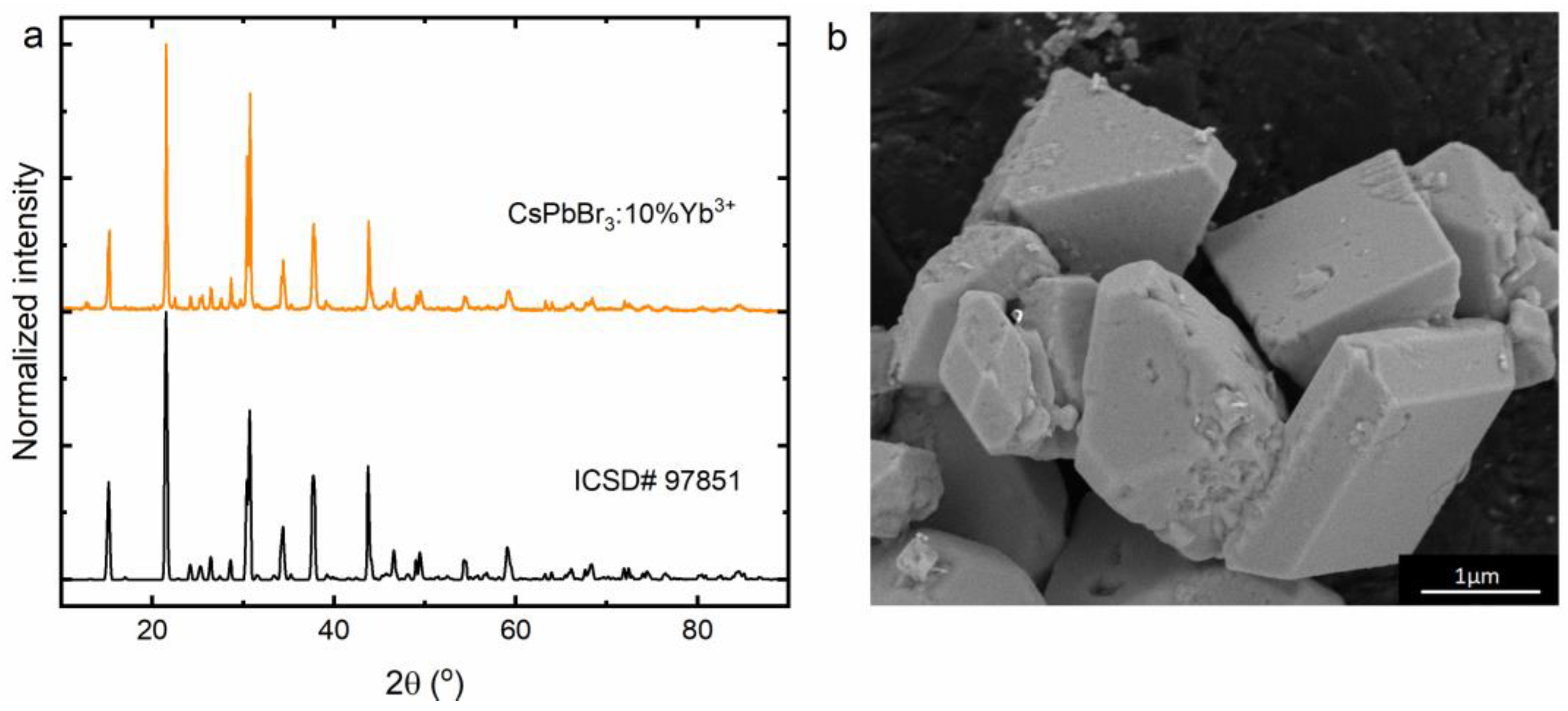
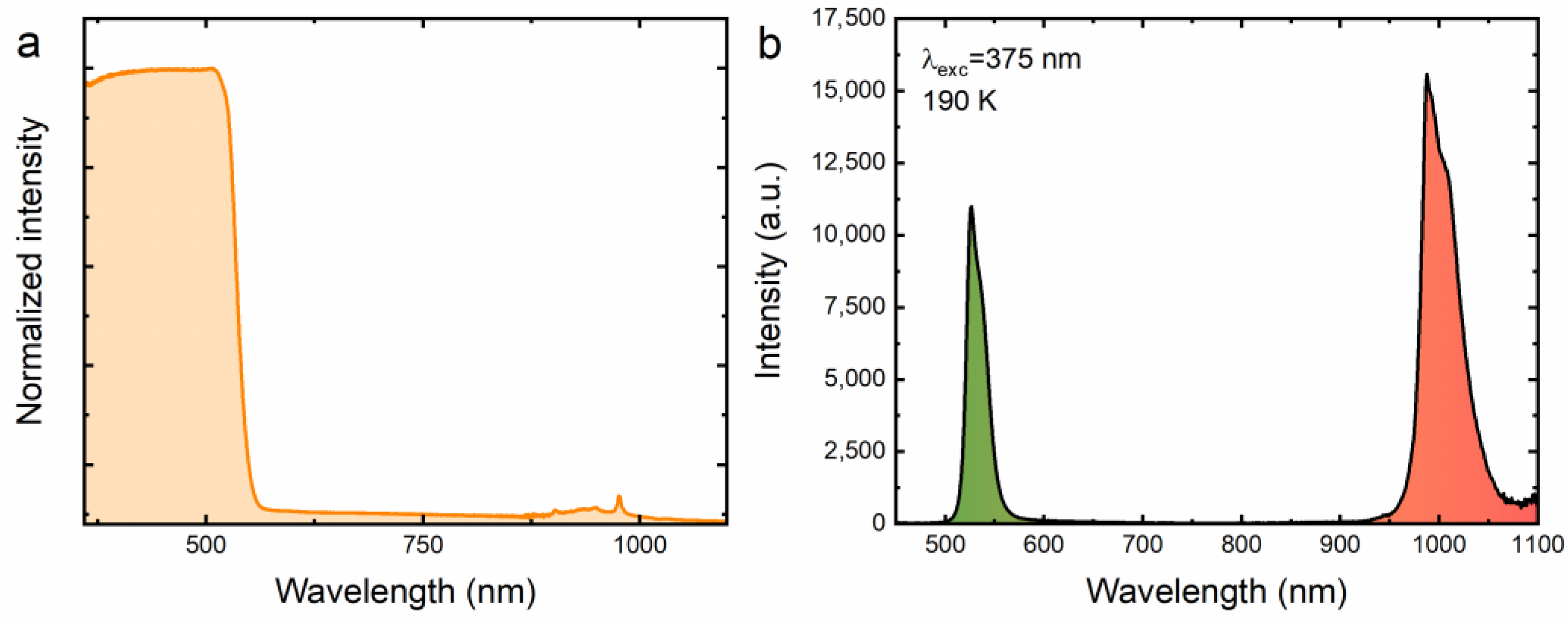

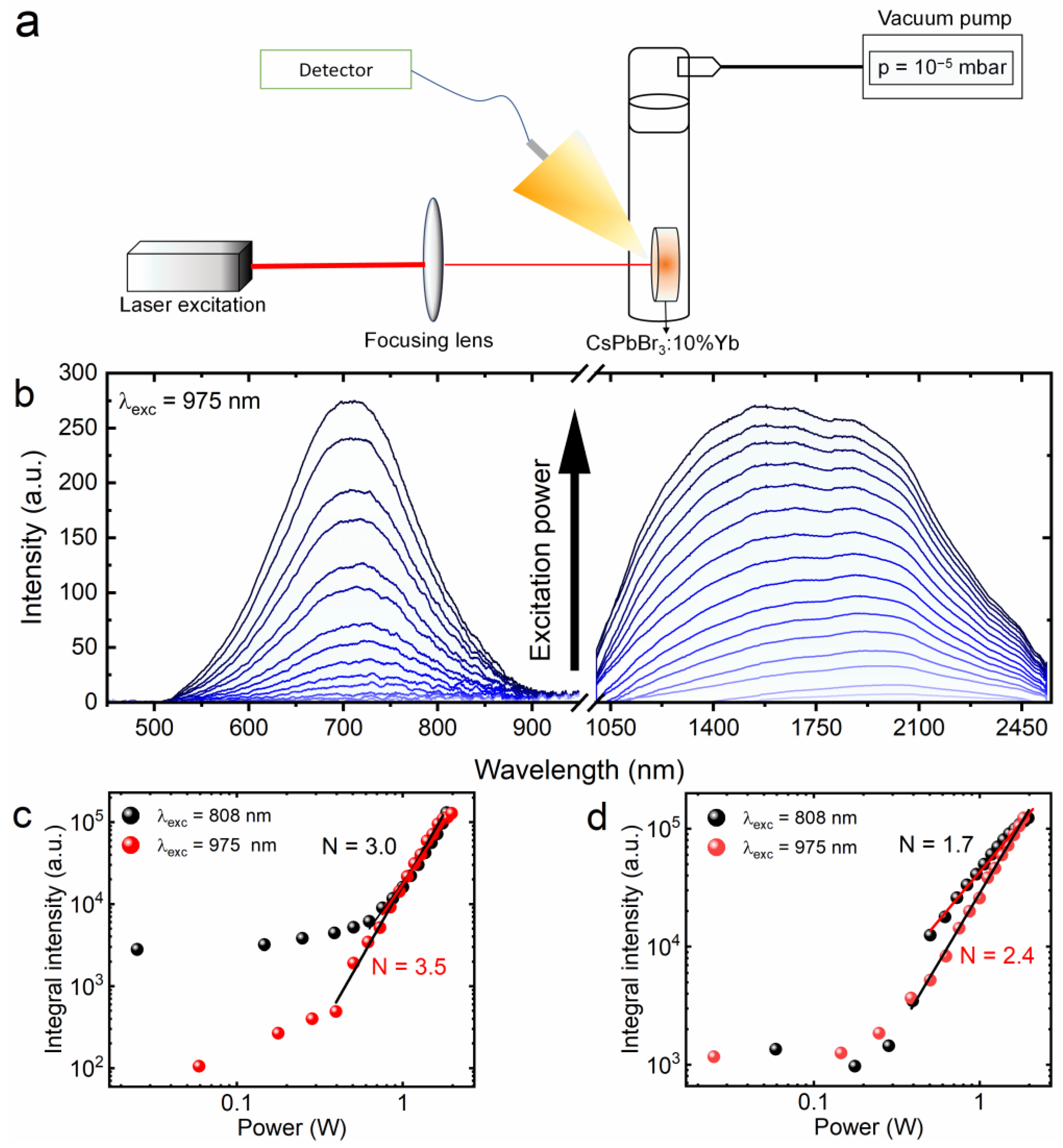
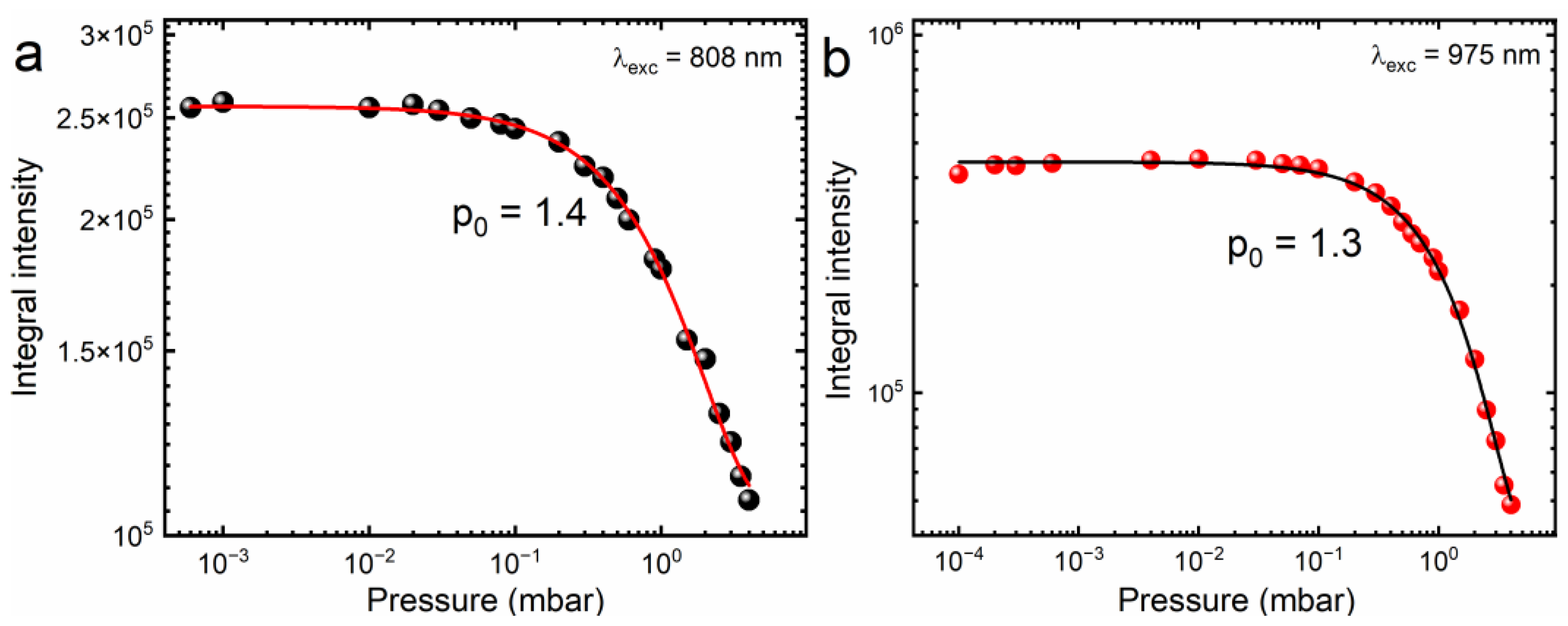
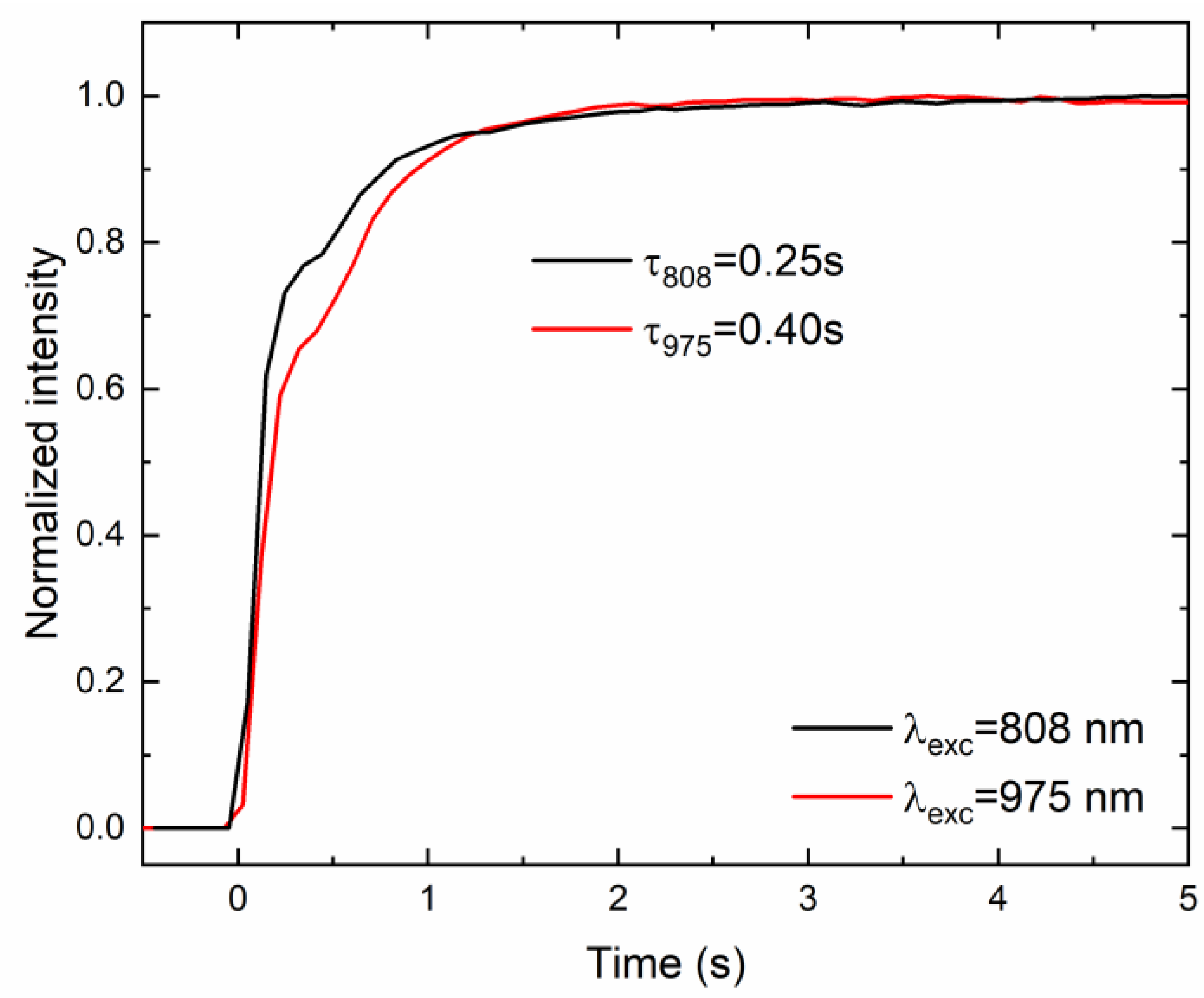


Disclaimer/Publisher’s Note: The statements, opinions and data contained in all publications are solely those of the individual author(s) and contributor(s) and not of MDPI and/or the editor(s). MDPI and/or the editor(s) disclaim responsibility for any injury to people or property resulting from any ideas, methods, instructions or products referred to in the content. |
© 2023 by the authors. Licensee MDPI, Basel, Switzerland. This article is an open access article distributed under the terms and conditions of the Creative Commons Attribution (CC BY) license (https://creativecommons.org/licenses/by/4.0/).
Share and Cite
Stefanski, M.; Gonçalves, J.M.; Strek, W. Broad Luminescence Generated by IR Laser Excitation from CsPbBr3:Yb3+ Perovskite Ceramics. Molecules 2023, 28, 5324. https://doi.org/10.3390/molecules28145324
Stefanski M, Gonçalves JM, Strek W. Broad Luminescence Generated by IR Laser Excitation from CsPbBr3:Yb3+ Perovskite Ceramics. Molecules. 2023; 28(14):5324. https://doi.org/10.3390/molecules28145324
Chicago/Turabian StyleStefanski, Mariusz, João Marcos Gonçalves, and Wieslaw Strek. 2023. "Broad Luminescence Generated by IR Laser Excitation from CsPbBr3:Yb3+ Perovskite Ceramics" Molecules 28, no. 14: 5324. https://doi.org/10.3390/molecules28145324





